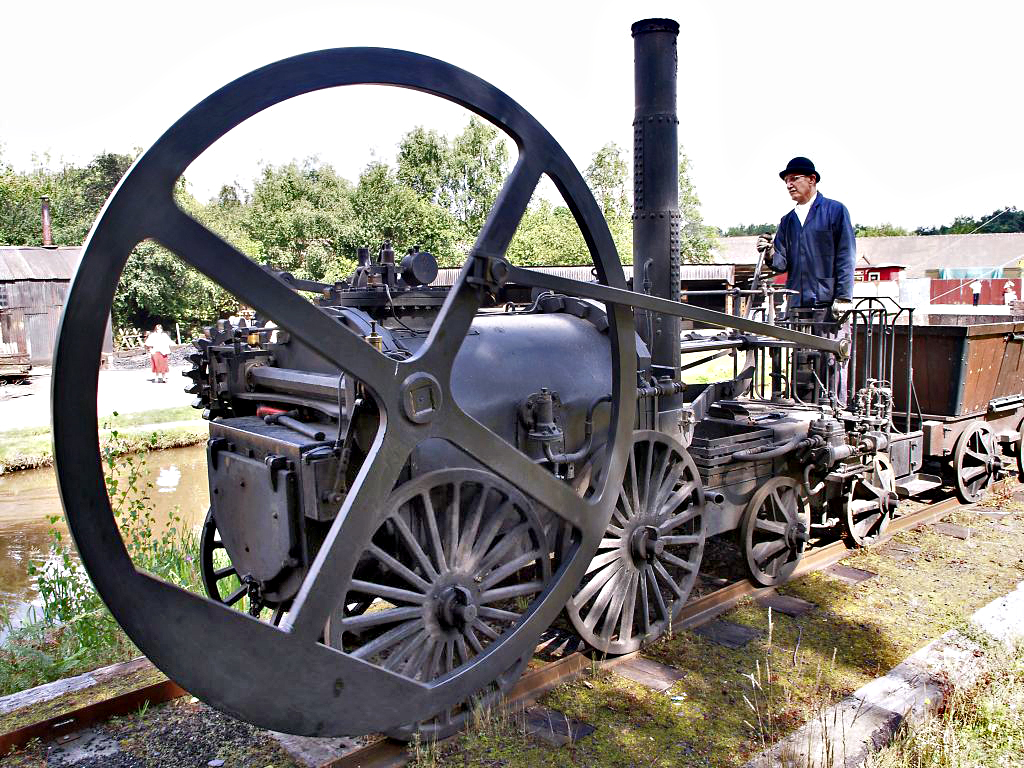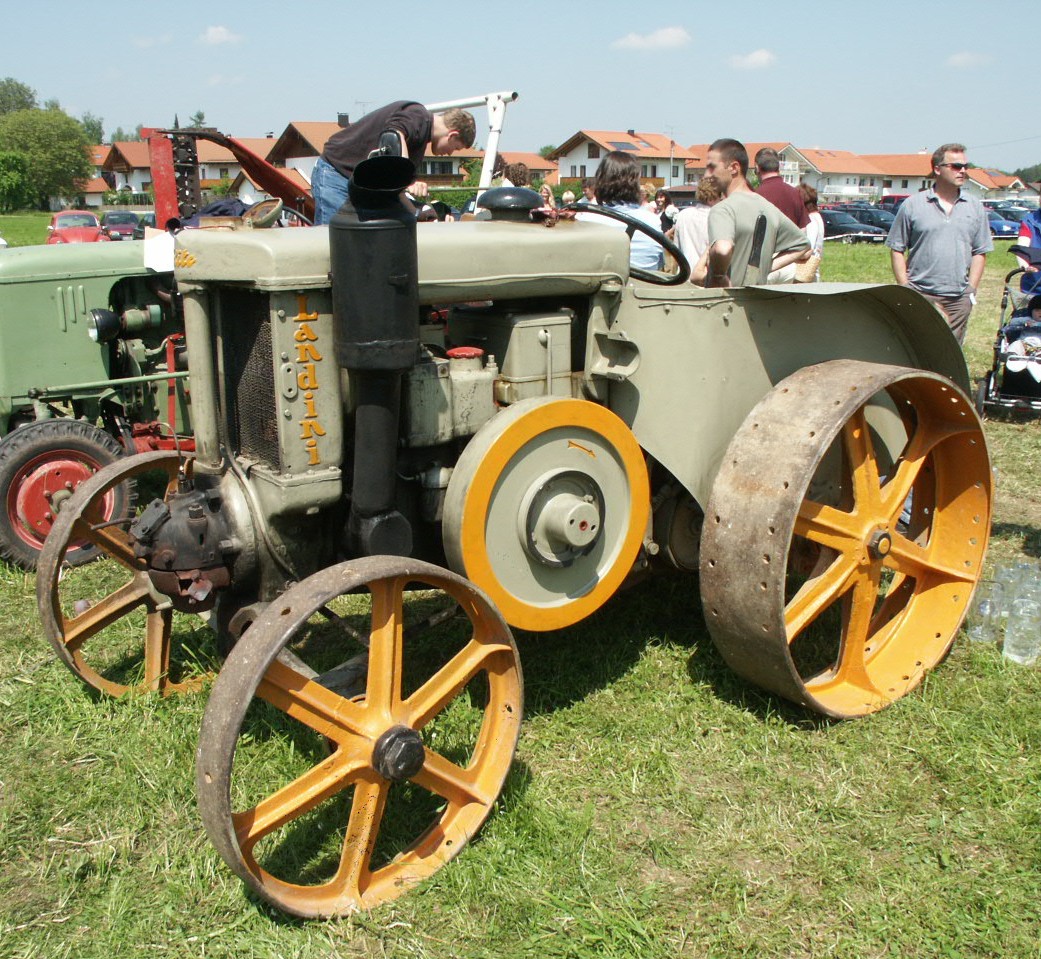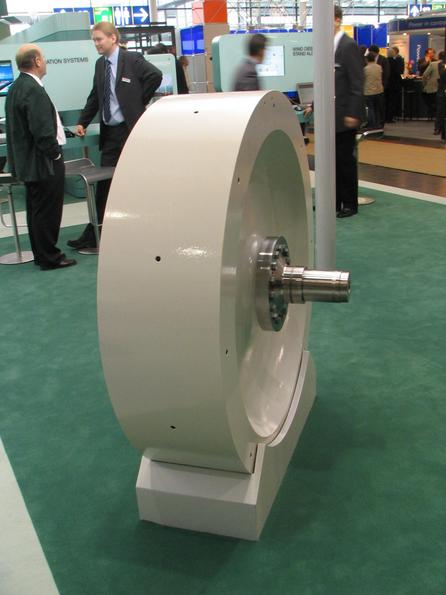Flywheel on:
[Wikipedia]
[Google]
[Amazon]
 A flywheel is a mechanical device which uses the conservation of
A flywheel is a mechanical device which uses the conservation of
 Flywheels are often used to provide continuous power output in systems where the energy source is not continuous. For example, a flywheel is used to smooth the fast angular velocity fluctuations of the crankshaft in a reciprocating engine. In this case, a crankshaft flywheel stores energy when torque is exerted on it by a firing piston and then returns that energy to the piston to compress a fresh charge of air and fuel. Another example is the friction motor which powers devices such as
Flywheels are often used to provide continuous power output in systems where the energy source is not continuous. For example, a flywheel is used to smooth the fast angular velocity fluctuations of the crankshaft in a reciprocating engine. In this case, a crankshaft flywheel stores energy when torque is exerted on it by a firing piston and then returns that energy to the piston to compress a fresh charge of air and fuel. Another example is the friction motor which powers devices such as
 A flywheel is a spinning wheel, or disc, or rotor, rotating around its symmetry axis. Energy is stored as kinetic energy, more specifically rotational energy, of the
A flywheel is a spinning wheel, or disc, or rotor, rotating around its symmetry axis. Energy is stored as kinetic energy, more specifically rotational energy, of the
Flywheel batteries
on ''Interesting Thing of the Day''.
Flywheel-based microgrid stabilisation technology.
 A flywheel is a mechanical device which uses the conservation of
A flywheel is a mechanical device which uses the conservation of angular momentum
In physics, angular momentum (rarely, moment of momentum or rotational momentum) is the rotational analog of linear momentum. It is an important physical quantity because it is a conserved quantity—the total angular momentum of a closed syst ...
to store rotational energy; a form of kinetic energy proportional to the product of its moment of inertia and the square of its rotational speed
Rotational frequency (also known as rotational speed or rate of rotation) of an object rotating around an axis is the frequency of rotation of the object. Its unit is revolution per minute (rpm), cycle per second (cps), etc.
The symbol fo ...
. In particular, assuming the flywheel's moment of inertia is constant (i.e., a flywheel with fixed mass and second moment of area
The second moment of area, or second area moment, or quadratic moment of area and also known as the area moment of inertia, is a geometrical property of an area which reflects how its points are distributed with regard to an arbitrary axis. The ...
revolving about some fixed axis) then the stored (rotational) energy is directly associated with the square of its rotational speed.
Since a flywheel serves to store mechanical energy for later use, it is natural to consider it as a kinetic energy analogue of an electrical inductor. Once suitably abstracted, this shared principle of energy storage is described in the generalized concept of an accumulator. As with other types of accumulators, a flywheel inherently smooths sufficiently small deviations in the power output of a system, thereby effectively playing the role of a low-pass filter
A low-pass filter is a filter that passes signals with a frequency lower than a selected cutoff frequency and attenuates signals with frequencies higher than the cutoff frequency. The exact frequency response of the filter depends on the filt ...
with respect to the mechanical velocity (angular, or otherwise) of the system. More precisely, a flywheel's stored energy will donate a surge in power output upon a drop in power input and will conversely absorb any excess power input (system-generated power) in the form of rotational energy.
Common uses of a flywheel include smoothing a power output in reciprocating engines, energy storage, delivering energy at higher rates than the source, controlling the orientation of a mechanical system using gyroscope and reaction wheel, etc. Flywheels are typically made of steel and rotate on conventional bearings; these are generally limited to a maximum revolution rate of a few thousand RPM.; "Flywheels move from steam age technology to Formula 1"; Jon Stewart , 1 July 2012, retrieved 2012-07-03 High energy density flywheels can be made of carbon fiber composites and employ magnetic bearing
A magnetic bearing is a type of bearing that supports a load using magnetic levitation. Magnetic bearings support moving parts without physical contact. For instance, they are able to levitate a rotating shaft and permit relative motion with v ...
s, enabling them to revolve at speeds up to 60,000 RPM (1 kHz)., "Breakthrough in Ricardo Kinergy ‘second generation’ high-speed flywheel technology"; Press release date: 22 August 2011. retrieved 2012-07-03Applications
toy car
A model car, or toy car, is a miniature representation of an automobile. Other miniature motor vehicles, such as trucks, buses, or even ATVs, etc. are often included in this general category. Because many miniature vehicles were originally aime ...
s. In unstressed and inexpensive cases, to save on cost, the bulk of the mass of the flywheel is toward the rim of the wheel. Pushing the mass away from the axis of rotation heightens rotational inertia for a given total mass.
A flywheel may also be used to supply intermittent pulses of energy at power levels that exceed the abilities of its energy source. This is achieved by accumulating energy in the flywheel over a period of time, at a rate that is compatible with the energy source, and then releasing energy at a much higher rate over a relatively short time when it is needed. For example, flywheels are used in power hammer
Power hammers are mechanical forging hammers that use an electrical power source or steam to raise the hammer preparatory to striking, and accelerate it onto the work being hammered. They are also called open die power forging hammers. They ha ...
s and riveting machines.
Flywheels can be used to control direction and oppose unwanted motions. Flywheels in this context have a wide range of applications: gyroscopes for instrumentation, ship stability, satellite stabilization ( reaction wheel), keeping a toy spin spinning ( friction motor), stabilizing magnetically-levitated objects ( Spin-stabilized magnetic levitation).
Flywheels may also be used as an electric compensator, like a synchronous compensator, that can either produce or sink reactive power but would not affect the real power. The purposes for that application are to improve the power factor of the system or adjust the grid voltage. Typically, the flywheels used in this field are similar in structure and installation as the synchronous motor (but it is called synchronous compensator or synchronous condenser in this context). There are also some other kinds of compensator using flywheels, like the single phase induction machine. But the basic ideas here are the same, the flywheels are controlled to spin exactly at the frequency which you want to compensate. For a synchronous compensator, you also need to keep the voltage of rotor and stator in phase, which is the same as keeping the magnetic field of rotor and the total magnetic field in phase (in the rotating frame reference).
History
The principle of the flywheel is found in theNeolithic
The Neolithic period, or New Stone Age, is an Old World archaeological period and the final division of the Stone Age. It saw the Neolithic Revolution, a wide-ranging set of developments that appear to have arisen independently in several p ...
spindle and the potter's wheel, as well as circular sharpening stones in antiquity.Lynn White, Jr., "Theophilus Redivivus", ''Technology and Culture'', Vol. 5, No. 2. (Spring, 1964), Review, pp. 224–233 (233) In early 11th century Ibn Bassal
Ibn Bassal ( ar, ابن بصال) was an 11th-century Andalusian Arab botanist and agronomist in Toledo and Seville, Spain who wrote about horticulture and arboriculture. He is best known for his book on agronomy, the ''Dīwān al-filāha'' (An ...
pioneered the used on flywheel in noria and saqiya. The use of the flywheel as a general mechanical device to equalize the speed of rotation is, according to the American medievalist Lynn White
Lynn Townsend White Jr. (April 29, 1907 – March 30, 1987) was an American historian. He was a professor of medieval history at Princeton from 1933 to 1937, and at Stanford from 1937 to 1943. He was president of Mills College, Oakland, from 1943 ...
, recorded in the ''De diversibus artibus'' (On various arts) of the German artisan Theophilus Presbyter
Theophilus Presbyter (fl. c. 1070–1125) is the pseudonymous author or compiler of a Latin text containing detailed descriptions of various medieval arts, a text commonly known as the ''Schedula diversarum artium'' ("List of various arts") or ''De ...
(ca. 1070–1125) who records applying the device in several of his machines. In the Industrial Revolution
The Industrial Revolution was the transition to new manufacturing processes in Great Britain, continental Europe, and the United States, that occurred during the period from around 1760 to about 1820–1840. This transition included going f ...
, James Watt contributed to the development of the flywheel in the steam engine, and his contemporary James Pickard used a flywheel combined with a crank to transform reciprocating motion into rotary motion.
Physics
 A flywheel is a spinning wheel, or disc, or rotor, rotating around its symmetry axis. Energy is stored as kinetic energy, more specifically rotational energy, of the
A flywheel is a spinning wheel, or disc, or rotor, rotating around its symmetry axis. Energy is stored as kinetic energy, more specifically rotational energy, of the rotor
Rotor may refer to:
Science and technology
Engineering
* Rotor (electric), the non-stationary part of an alternator or electric motor, operating with a stationary element so called the stator
*Helicopter rotor, the rotary wing(s) of a rotorcraft ...
, and can be calculated by . ω is the angular velocity, and is the moment of inertia of the flywheel about its axis of symmetry. The moment of inertia is a measure of resistance to torque applied on a spinning object (i.e. the higher the moment of inertia, the slower it will accelerate when a given torque is applied). The moment of inertia can be known by mass () and radius (). For a solid cylinder it is , for a thin-walled empty cylinder it is approximately , and for a thick-walled empty cylinder with constant density it is .
An electric motor-powered flywheel is common in practice. The output power of the electric motor is approximately equal to the output power of the flywheel. It can be calculated by , where is the voltage of rotor
Rotor may refer to:
Science and technology
Engineering
* Rotor (electric), the non-stationary part of an alternator or electric motor, operating with a stationary element so called the stator
*Helicopter rotor, the rotary wing(s) of a rotorcraft ...
winding, is stator voltage, and is the angle between two voltages. Increasing amounts of rotation energy can be stored in the flywheel until the rotor shatters. This happens when the hoop stress within the rotor exceeds the ultimate tensile strength of the rotor material. Tensile stress can be calculated by , where is the density of the cylinder, is the radius of the cylinder, and is the angular velocity of the cylinder.
Material selection
Flywheels are made from many different materials; the application determines the choice of material. Small flywheels made of lead are found in children's toys. Cast iron flywheels are used in old steam engines. Flywheels used in car engines are made of cast or nodular iron, steel or aluminum. Flywheels made from high-strength steel or composites have been proposed for use in vehicle energy storage and braking systems. The efficiency of a flywheel is determined by the maximum amount of energy it can store per unit weight. As the flywheel's rotational speed or angular velocity is increased, the stored energy increases; however, the stresses also increase. If the hoop stress surpass the tensile strength of the material, the flywheel will break apart. Thus, the tensile strength limits the amount of energy that a flywheel can store. In this context, using lead for a flywheel in a child's toy is not efficient; however, the flywheel velocity never approaches its burst velocity because the limit in this case is the pulling-power of the child. In other applications, such as an automobile, the flywheel operates at a specified angular velocity and is constrained by the space it must fit in, so the goal is to maximize the stored energy per unit volume. The material selection therefore depends on the application.Energy storage
For a given flywheel design, the kinetic energy is proportional to the ratio of the hoop stress to the material density and to the mass. The specific tensile strength of a flywheel can be defined as . The flywheel material with the highest specific tensile strength will yield the highest energy storage per unit mass. This is one reason why carbon fiber is a material of interest. For a given design the stored energy is proportional to the hoop stress and the volume.Design
A rimmed flywheel has a rim, a hub, andspokes
A spoke is one of some number of rods radiating from the center of a wheel (the hub where the axle connects), connecting the hub with the round traction surface.
The term originally referred to portions of a log that had been riven (split l ...
. Calculation of the flywheel's moment of inertia can be more easily analysed by applying various simplifications. One method is to assume the spokes, shaft and hub have zero moments of inertia, and the flywheel's moment of inertia is from the rim alone. Another is to lump
Lump may refer to:
* "Lump" (song), a 1995 song by The Presidents of the United States of America
* ''Lump'' (compilation album), a 2000 best-of album by The Presidents of the United States of America
* Lump (dog), a dog who inspired Pablo Pica ...
moments of inertia of spokes, hub and shaft may be estimated as a percentage of the flywheel's moment of inertia, with the majority from the rim, so that . For example, if the moments of inertia of hub, spokes and shaft are deemed negligible, and the rim's thickness is very small compared to its mean radius (), the radius of rotation of the rim is equal to its mean radius and thus .
A shaftless flywheel eliminates the annulus holes, shaft or hub. It has higher energy density than conventional design but requires a specialized magnetic bearing and control system. The specific energy of a flywheel is determined by, in which is the shape factor, the material's tensile strength and the density. While a typical flywheel has a shape factor of 0.3, the shaftless flywheel has a shape factor close to 0.6, out of a theoretical limit of about 1.
A superflywheel consists of a solid core (hub) and multiple thin layers of high-strength flexible materials (such as special steels, carbon fiber composites, glass fiber, or graphene) wound around it. Compared to conventional flywheels, superflywheels can store more energy and are safer to operate. In case of failure, a superflywheel does not explode or burst into large shards like a regular flywheel, but instead splits into layers. The separated layers then slow a superflywheel down by sliding against the inner walls of the enclosure, thus preventing any further destruction. Although the exact value of energy density of a superflywheel would depend on the material used, it could theoretically be as high as 1200 Wh (4.4 MJ) per kg of mass for graphene superflywheels. The first superflywheel was patented in 1964 by the Soviet-Russian scientist Nurbei Guilia.
See also
* Dual-mass flywheel *Flywheel energy storage
Flywheel energy storage (FES) works by accelerating a rotor (flywheel) to a very high speed and maintaining the energy in the system as rotational energy. When energy is extracted from the system, the flywheel's rotational speed is reduced as a c ...
* Accumulator (energy)
* Diesel rotary uninterruptible power supply
* List of moments of inertia
Moment of inertia, denoted by , measures the extent to which an object resists rotational acceleration about a particular axis, it is the rotational analogue to mass (which determines an object's resistance to ''linear'' acceleration). The momen ...
* Clutch
* Fidget Spinner
A fidget spinner is a toy that consists of a ball bearing in the center of a multi-lobed (typically two or three) flat structure made from metal or plastic designed to spin along its axis with pressure. Fidget spinners became trending toys in 2 ...
* Flywheel training
References
Further reading
* * * https://pserc.wisc.edu/documents/general_information/presentations/presentations_by_pserc_university_members/heydt_synchronous_mach_sep03.pdfExternal links
*Flywheel batteries
on ''Interesting Thing of the Day''.
Flywheel-based microgrid stabilisation technology.
ABB
ABB Ltd. is a Swedish- Swiss multinational corporation headquartered in Zürich, Switzerland. The company was formed in 1988 when Sweden's Allmänna Svenska Elektriska Aktiebolaget (ASEA) and Switzerland's Brown, Boveri & Cie merged to crea ...
{{Authority control
Articles containing video clips